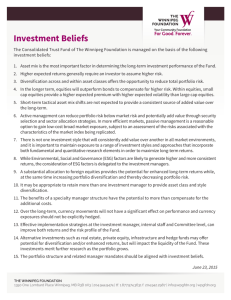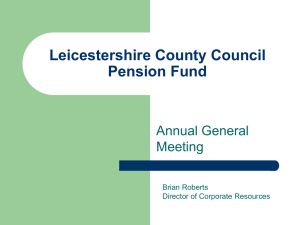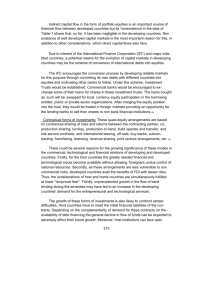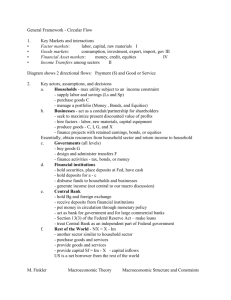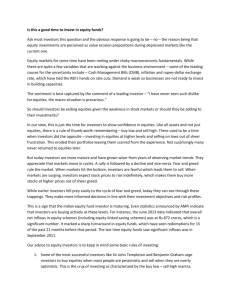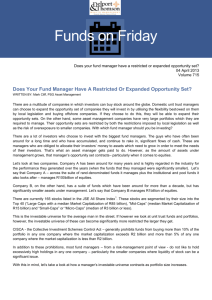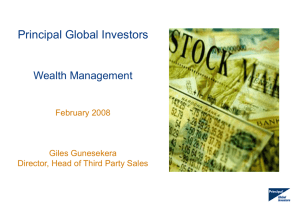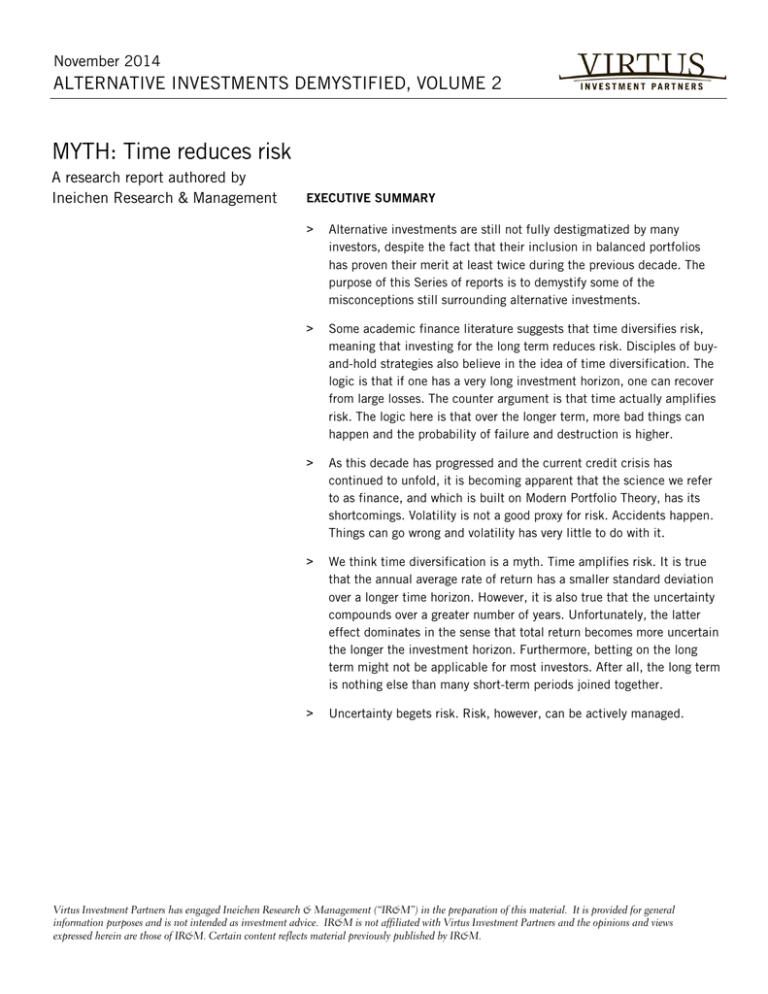
November 2014
ALTERNATIVE INVESTMENTS DEMYSTIFIED, VOLUME 2
MYTH: Time reduces risk
A research report authored by
Ineichen Research & Management
EXECUTIVE SUMMARY
>
Alternative investments are still not fully destigmatized by many
investors, despite the fact that their inclusion in balanced portfolios
has proven their merit at least twice during the previous decade. The
purpose of this Series of reports is to demystify some of the
misconceptions still surrounding alternative investments.
>
Some academic finance literature suggests that time diversifies risk,
meaning that investing for the long term reduces risk. Disciples of buyand-hold strategies also believe in the idea of time diversification. The
logic is that if one has a very long investment horizon, one can recover
from large losses. The counter argument is that time actually amplifies
risk. The logic here is that over the longer term, more bad things can
happen and the probability of failure and destruction is higher.
>
As this decade has progressed and the current credit crisis has
continued to unfold, it is becoming apparent that the science we refer
to as finance, and which is built on Modern Portfolio Theory, has its
shortcomings. Volatility is not a good proxy for risk. Accidents happen.
Things can go wrong and volatility has very little to do with it.
>
We think time diversification is a myth. Time amplifies risk. It is true
that the annual average rate of return has a smaller standard deviation
over a longer time horizon. However, it is also true that the uncertainty
compounds over a greater number of years. Unfortunately, the latter
effect dominates in the sense that total return becomes more uncertain
the longer the investment horizon. Furthermore, betting on the long
term might not be applicable for most investors. After all, the long term
is nothing else than many short-term periods joined together.
>
Uncertainty begets risk. Risk, however, can be actively managed.
Virtus Investment Partners has engaged Ineichen Research & Management (“IR&M”) in the preparation of this material. It is provided for general
information purposes and is not intended as investment advice. IR&M is not affiliated with Virtus Investment Partners and the opinions and views
expressed herein are those of IR&M. Certain content reflects material previously published by IR&M.
MYTH: Time reduces risk
November 2014
“A smart girl leaves before she is left.”
—Marilyn Monroe
Time diversification
Over the past 20 years or so there has been a debate—sometimes referred to
as the “time diversification controversy”—as to whether time reduces or
“diversifies” risk, or whether risk is amplified when the investment horizon is
lengthened. There are essentially two camps. One school of thought is that
time reduces risk; the other argues that time increases risk. Conventional
wisdom suggests that over long horizons, above-average returns tend to offset
below-average returns. In addition, volatility decreases with time and the
probability of (end-of-period) loss also falls with time. However, if the
magnitude of potential loss defines risk, then risk increases with time. The
probability, for example, of San Francisco being wiped out by a large
earthquake over the next 200 years is much larger than over the next 200
days. The bottom line is, as Mark Kritzman, a senior lecturer and investor
and an authority on the subject, put it in 2000:
The time diversification
controversy depends on how we
define risk
“The truth is that risk has no universal definition; rather like beauty, it is
in the eyes of the beholder.”
We believe the consensus on the topic is the former, i.e., the idea that time
indeed diversifies risk. The premise of investing in a long-only buy-and-hold
fashion is that short-term volatility is ironed out over the long run. This is true
if risk is defined as volatility (annualized standard deviation of returns). If
one has an investment horizon of 25 years or longer, one has the time “to sit
it out” and recover from large dislocations in the market. In addition, equities
have a higher probability of outperforming government bonds over 25 years
than over one year. Many institutional investors have the financial stability
and liquidity to handle a downturn in the market, even with a large allocation
to long-only equities. For these plans, any amount not invested in equities
may simply reduce the long-term growth of assets with no offsetting benefit.
“The long run is a misleading
guide to current affairs. In the
long run we are all dead.
Economists set themselves too
easy, too useless a task if in the
tempestuous seasons they only
tell us that when the storm is past
the ocean will be flat.”
—John Maynard Keynes (18831946), British economist
We think time diversification is a myth. Time amplifies risk. It is true that the
annual average rate of return has a smaller standard deviation for a longer
time horizon. However, it is also true that the uncertainty compounds over a
greater number of years. Unfortunately, this effect dominates in the sense
that the total return becomes more uncertain the longer the investment
horizon. After all, the long term is nothing more than many short-term
periods joined together.
“Forever is composed of nows.”
—Emily Dickinson (1830-1886),
American poet
Page 2
MYTH: Time reduces risk
November 2014
As this decade has progressed and the current credit crisis has continued
to unfold (overall debt-to-GDP ratios have risen since the financial crisis,
not fallen), it is becoming apparent that the science we refer to as finance,
and which is built on Modern Portfolio Theory, has its shortcomings.
Volatility is not a good proxy for risk. As the British economist Lord Bauer
put it: “A safe investment is an investment whose dangers are not at that
moment apparent.” Accidents happen. Things can go wrong and volatility
has very little to do with it. Uncertainty begets risk. Risk, however, can be
actively managed.
“The reason lightning doesn’t
strike twice in the same place is
that the same place isn’t there
the second time.”
—Willie Tyler, American
ventriloquist, comedian, and actor
In the following section, we discuss the long-term performance of Japanese
equities to demonstrate that blindly relying on the long term might not be
pragmatic, despite the time diversification debate. We do not believe that
there is a sound argument that recent Japanese economic history is entirely
irrelevant for U.S. investors. After all, Japan does not have a monopoly when
it comes to economic failure and policy error.
Figure 1: Japanese equities (January 2000 – August 2014): long-only versus long-short
Index in percent of previous high, %
100
2019
Recovery assuming Topix TR starts compounding at 4% p.a.
80
60
40
20
0
2000
2005
Equities (long-only)
2010
Equities (long-short)
2015
2020
Source: IR&M, Bloomberg. Past performance is no guarantee of future results.
Note: Based on Topix TR Index and Eurekahedge Japan Long Short Equities Hedge Fund Index
Figure 1 is a drawdown chart (showing losses as a percentage of the previous
all-time high) which uses a Japanese equity index (Topix Total Return Index)
as a proxy for a long-only strategy in Japan and an equities long-short index
(Eurekahedge Japan Long Short Equities Hedge Fund Index) comprised of
hedge funds investing in Japanese equities in a long-short fashion. The
dotted line assumes the Topix Index starts compounding at 4% per year from
September 2014 onwards. In such a scenario, the Index would reach its
previous high from 2008 around the year 2019. (If the Index starts
compounding at 4%, and assuming dividends are re-invested and not taxed
and spent, the all-time Index high from December 1989 would be reached
around the year 2027.)
Compounding capital negatively
over many decades is a possibility
Page 3
MYTH: Time reduces risk
November 2014
Equities are expected to rise in the long run; time is supposed to diversify/reduce
risk. However, from January 1990 to August 2014, the Topix Index compounded
at an annual rate of -0.5%. (We have chosen Japan to demonstrate that equity
markets can fall materially and not recover, even in modern times.) The trajectory
in Figure 1 shows the Index assuming compounding continues at a rate of 4%
per year. In theory, mean reversion is one of the most powerful concepts in
finance as dead cats nearly always bounce. However, it doesn’t always seem to
work. Or it might take too long to be a practical concept on which to bet. There is
uncertainty regarding the reversion to the mean. Sometimes the cat dies and
that’s just the end of the story.
“Reversion to the mean is the iron
rule of the financial markets.”
—John C. Bogle, Founder of
The Vanguard Group
Empirical research suggests that equities go up in the long term, and in the
long term, equities outperform bonds. This is true, especially when ignoring
hyperinflation and gaps in the data. However, the practical issue with the
long term, as British economist John Maynard Keynes so famously put it, is
that you might not live long enough to experience the long term. The
empirical research might be true, but it is of little practical relevance for
most investors. To illustrate this point, Figure 2 shows a selection of
historical equity market peaks (each set to 100), two years prior to peak, and
20 years after the peak.
“A long-term investment is a
short-term investment that has
failed.”
—Saying
Figure 2: Equity market bubbles and time to recover losses
Source: IR&M, Bloomberg. Past performance is no guarantee of future results.
The S&P 500® Index reached a peak in 2007 and recovered swiftly. This is
the exception to the rule. It was only possible with unprecedented
intervention from government authorities. The other extremes are the S&P
500 after its 1929 peak and the Nikkei 225 after its 1989 peak: 20 years
after their peaks, the indexes still were underwater by 52% and 73%,
respectively. The Nasdaq Composite, at the time of writing, had not yet
recovered its peak from 14 years ago.
“A random market movement
causing the average investor to
mistake himself for a financial
genius.”
—Alternative definition of an
equity bull market
Page 4
MYTH: Time reduces risk
November 2014
What is true for equities is true for bonds too. Figure 3 shows another
drawdown chart, in this case U.S. equities and bonds in real terms (adjusted
for inflation), since 1990.
Figure 3: Underwater perspective of U.S. equities and bonds (January 1900 – August 2014)
Index as percentage of previous all-time-high (%)
48 years (Dec 1940 - Oct 1988)
100
90
80
70
60
50
40
30
20
10
0
1900
1910
1920
1930
1940
1950
US equities in real terms
1960
1970
1980
1990
2000
2010
US bonds in real terms
Source: IR&M, Bloomberg. Past performance is no guarantee of future results.
While equities can spend a long time “underwater,” bonds can compound at
a negative rate for a long time too. U.S. bonds started to produce losses
around December 1940 and had not recovered, in real terms, until October
1988, roughly 48 years later. So much for time diversifying risk.
The time diversification controversy is not the only debate with regard to
losses and risk management that has been revisited in the post-2008
financial crisis era. The financial crisis has shown that not everything that
matters can be measured. The idea that time diversifies risk rests on the
assumption that risk can be measured—it cannot, or at least not perfectly. As
practitioners, it makes sense to distinguish between risk and uncertainty.
“Not everything that can be
counted counts, and not
everything that counts can be
counted.”
—Albert Einstein (1879-1955),
Physicist
Page 5
MYTH: Time reduces risk
November 2014
Confusing risk measurement and risk management
Many investors have been beefing up their risk management capabilities
since the last financial crisis, partly due to increased regulation and partly
because of an after-the-accident learning experience. It has become apparent
that some of the beliefs and assumptions, which were formed during the
historic equity bull market that ended in 2000, are false, misleading,
dangerous, or not applicable. Risk management (as opposed to risk
measurement) deals with changing one’s portfolio in response to an everchanging environment or changing rules that happened to have worked fine
in the past. The future is uncertain. The only thing we really know for sure is
that the status quo is going to change. Risk management, we believe, is the
thought process that balances investment opportunities with the probability
of capital depreciation.
“Doubt is not a pleasant state of
mind, but certainty is absurd.”
—Voltaire (1694-1778), French
writer
The front cover of Risk by John Adams (the U.K. geographer, not the U.S.
president) depicts a black area, with a small square in the lower left and an
even smaller square in the upper right. Adams refers to a 1983 report from
the National Research Council in the U.S. which noted that about five million
different chemical substances are known to exist and that their safety is
theoretically under regulatory jurisdiction. Of these, about 7,000 have been
tested for causing cancer (larger white square in the lower left), while fewer
than 30 have been definitively linked to cancer in humans (small white
square in the upper right identified by the white arrow). The proportion of
each white square and dot to the black space is the same as the proportion of
7,000 tested substances and 30 discovered carcinogenic substances to the
five million chemical substances. Adams calls the dark space “darkness of
ignorance.” We just do not know the carcinogenic effects of most substances.
Our knowledge is limited. The same is true in finance. We don’t know much
about the future. There is an extreme asymmetry between the little we do
know and what we don’t. There is uncertainty. If you think about it this way,
equating risk with volatility of traded securities becomes a rather silly
endeavor. This suggests that the theory on which the idea of time
diversification rests is either false or not applicable for most investors.
One important aspect of risk management is the term “unknown unknowns.”
In finance, we tend to distinguish between “risk” and “uncertainty,” also
known as Knightian Uncertainty, named after American economist Frank
Knight (1885-1972). When discussing matters related to risk, we assume we
know the distribution from which destiny will pick future events (quite often
a normal distribution is assumed). This is the reason why financial textbooks
always discuss coin flipping games or examples with dice or roulette tables.
In these instances, the probabilities can be calculated exactly. Uncertainty is
not the same as risk though. It is a term used in subtly different ways in a
number of fields, including philosophy, statistics, economics, finance,
insurance, psychology, engineering, and science. It applies to predictions of
future events, to physical measurements already made, or to the unknown.
“There are known knowns. These
are things we know that we know.
There are known unknowns.
That is to say, there are things
that we now know we don’t
know. But there are also
unknown unknowns. There are
things we do not know we don’t
know.”
—Donald Rumsfeld in 2002,
former U.S. Secretary of Defense
(2001-2006)
Page 6
MYTH: Time reduces risk
November 2014
Concluding remarks
It goes without saying that, for practical purposes, it is uncertainty that
matters, not risk. We can apply rigorous quantitative analysis to matters
related to risk, but not to uncertainty. Many practitioners have moved away
from normal distributions and pretentious mathematical precision, strongly
influenced by Nassim Taleb’s work and the “learning by doing” experience
that was the financial crisis. To deal with uncertainty requires thought and,
most likely, common sense. Frank Knight argued that profits should be
defined as the reward for bearing uncertainty.
“One of the greatest pieces of
economic wisdom is to know
what you do not know.”
—John Kenneth Galbraith (19082006), Canadian-American
economist
The diversification idea—to many the only free lunch in finance—is based on
the premise that we don’t know the future. If we knew that wind farms would
yield the best 10-year point return, there would be no need to care about risk
or time diversification. Diversification is for those who know what they don’t
know. All other investors either don’t know what they don’t know or bought
into a potentially false doctrine from which the only cure is substantial
losses. “Learning by doing” is an important adage in risk management and
experience a cruel and expensive teacher.
“Time is the best teacher, but
unfortunately, it kills all of its
students.”
—Robin Williams (1951-2014),
American actor and comedian
Copyright © 2014 by Ineichen Research and Management AG, Switzerland
All rights reserved. Reproduction or retransmission in whole or in part is prohibited except by permission. The information set forth in this document has been
obtained from publicly available sources, unless stated otherwise. All information contained in this report is based on information obtained from sources which
Ineichen Research and Management (“IR&M”) believes to be reliable. IR&M provides this report without guarantee of any kind regarding its contents.
This document is for information purposes only and should not be construed as investment advice or an offer to sell (nor the solicitation of an offer to buy) any of
the securities it refers to. The information has not been independently verified by IR&M or any of its affiliates. Neither IR&M nor any of its affiliates makes any
representations or warranties regarding, or assumes any responsibility for the accuracy, reliability, completeness or applicability of, any information, calculations
contained herein, or of any assumptions underlying any information, calculations, estimates, or projections contained or reflected herein. Neither this document
nor the securities referred to herein have been registered or approved by any regulatory authority of any country or jurisdiction.
This material is intended solely for the information of the person to whom it has been delivered and may not be distributed in any jurisdiction where such
distribution would constitute a violation of applicable law or regulation.
While this document represents the author’s understanding at the time it was prepared, no representation or warranty, either expressed or implied, is provided in
relation to the accuracy, completeness or reliability of the information contained herein, nor it is intended to be a complete statement or summary of the securities
markets or developments referred to in the document. It should not be regarded by recipients as a substitute for the exercise of their own judgment.
Investing in securities and other financial products entails certain risks, including the possible loss of the entire amount invested. Certain investments in
particular, including those involving structured products, futures, options and other derivatives, are complex, may entail substantial risk and are not suitable for
all investors. The price and value of, and income produced by, securities and other financial products may fluctuate and may be adversely impacted by exchange
rates, interest rates, or other factors. Information available on such securities may be limited. The securities described herein may not be eligible for sale in all
jurisdictions or to certain categories of investors. You should obtain advice from your own tax, financial, legal, and accounting advisers to the extent that you
deem necessary and only make investment decisions on the basis of your objectives, experience, and resources.
Past performance is not necessarily indicative of future results.
Unless specifically stated otherwise, all price information is indicative only.
No liability whatsoever is accepted for any loss (whether direct, indirect, or consequential) that may arise from any use of the information contained in or derived
from this document. IR&M does not provide tax advice and nothing contained herein is intended to be, or should be construed as tax advice. Recipients of this
report should seek tax advice based on the recipient’s own particular circumstances from an independent tax adviser.
Page 7
MYTH: Time reduces risk
Ineichen Research and Management AG (“IR&M”) is a research firm focusing on
investment themes related to absolute returns and risk management.
The firm was founded in October, 2009 by Alexander Ineichen. Mr. Ineichen started
his financial career in derivatives brokerage and origination of risk management
products at Swiss Bank Corporation in 1988. From 1991 to 2005, he had various
research functions within UBS Investment Bank in Zurich and London relating to
equity derivatives, indices, capital flows, and alternative investments, since 2002 in
the role of a Managing Director. From 2005 to 2008 he was a Senior Investment
Officer with Alternative Investment Solutions, a fund of hedge funds within UBS
Global Asset Management. In 2009 he was Head of Industry Research for the hedge
fund platform at UBS Global Asset Management.
November 2014
Alexander Ineichen CFA, CAIA, FRM
+41 41 511 2497
ai@ineichen-rm.com
www.ineichen-rm.com
Mr. Ineichen is the author of two publications “In Search of Alpha – Investing in
Hedge Funds” (October 2000) and “The Search for Alpha Continues – Do Fund of
Hedge Funds Add Value?” (September 2001). These two documents were the most
often printed research publications in the documented history of UBS. He is also
author of “Absolute Returns – The Risk and Opportunities of Hedge Fund Investing”
(Wiley Finance, October 2002) and “Asymmetric Returns – The Future of Active Asset
Management” (Wiley Finance, November 2006). He has also written several research
pieces pertaining to equity derivatives and hedge funds and contributed to several
chapters to financial books. He also wrote “AIMA’s Roadmap to Hedge Funds”
(November 2008) which was, at that time, the most often downloaded document from
their website.
Mr. Ineichen holds a Bachelor of Science in Business Administration with Major in
General Management from the Universities of Applied Sciences in Business
Administration in Zurich (HWZ), Switzerland. He holds the Chartered Financial
Analyst (CFA) and Chartered Alternative Investment Analyst (CAIA) designations and
is a certified Financial Risk Manager (FRM). He is on the Board of Directors of the
CAIA Association and is a member of the AIMA Research Committee.
For more information
on the realities of
alternative investing,
please visit Virtus.com
or contact us at
1-800-243-4361.
6746 11-14 © Virtus Investment Partners, Inc.
Page 8

